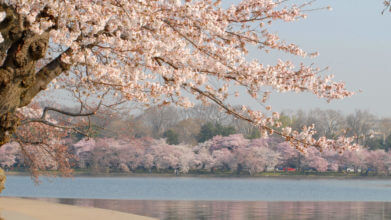Washington DC Neighborhood Guide
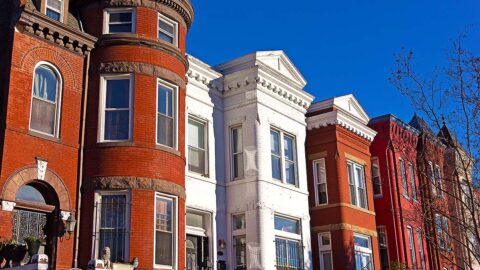
Explore the Best Neighborhoods in DC
Washington, DC is not just the political epicenter of America, it is a city filled with a multitude of neighborhoods, each exuding its own distinct allure. If you’re planning a visit to the Nation’s Capital, exploring the best neighborhoods in DC should be at the top of your itinerary. Including these neighborhoods in your trip plan will undoubtedly enrich your DC experience, making for unforgettable memories.
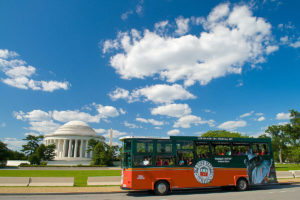 The Old Town Trolley is a great choice for exploring some of these DC neighborhoods. This iconic mode of transport lends an old-world charm to your journey, adding a layer of nostalgia to your sightseeing experience. As it meanders through the iconic streets of the city, it offers unobstructed views of the architectural marvels and landscape features that define the various neighborhoods. With knowledgeable tour guides offering insights into the historical and cultural significance of the landmarks, the trolley experience becomes an educational tour that is both enriching and entertaining. Plus, the hop-on, hop-off feature ensures flexibility, so you can explore each neighborhood at your own pace.
The Old Town Trolley is a great choice for exploring some of these DC neighborhoods. This iconic mode of transport lends an old-world charm to your journey, adding a layer of nostalgia to your sightseeing experience. As it meanders through the iconic streets of the city, it offers unobstructed views of the architectural marvels and landscape features that define the various neighborhoods. With knowledgeable tour guides offering insights into the historical and cultural significance of the landmarks, the trolley experience becomes an educational tour that is both enriching and entertaining. Plus, the hop-on, hop-off feature ensures flexibility, so you can explore each neighborhood at your own pace.
Dupont Circle History
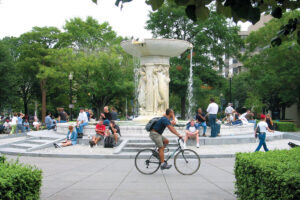
Over time, Dupont Circle morphed into a cultural hub, welcoming the LGBTQ+ community and embracing progressive movements. The Roaring Twenties brought vibrant nightlife along Connecticut Avenue, while the original Dupont statue was replaced by the iconic fountain we see today. Now a bustling center for diverse restaurants, shops, and institutions, Dupont Circle retains its historical charm and progressive spirit, standing as a testament to its captivating evolution.
Things To Do in Dupont Circle
Immerse yourself in art and culture by visiting well-known museums. The Dupont Underground, a unique underground art gallery showcases contemporary art in a dynamic and intimate setting. America’s first museum of modern art, the Phillips Collection, houses an impressive collection of Impressionist, post-Impressionist, and modern works. Wander through the elegant mansion and marvel at masterpieces by Renoir, Monet, and Van Gogh. Journey through the world’s wonders at the National Geographic Museum, where captivating exhibits transport you to far-flung destinations and bring science and exploration to life.
Dupont Circle is also known for a number of historic sites. Explore the life and legacy of President Woodrow Wilson at his meticulously preserved home, now a National Historic Landmark. Visit Anderson House, a Georgian-style mansion built in 1783 that served as headquarters for Continental Army Major General Nathanael Greene during the Revolutionary War. Today, it offers a glimpse into 18th-century life. Stroll down Embassy Row on Massachusetts Avenue and admire the grandeur of the many foreign embassies lining the street. Each embassy reflects the unique architecture and culture of its respective country.
Connecticut Street, a bustling street lined with an array of restaurants and cafes, offers everything from casual cafes to fine dining experiences. Explore international cuisines, sample local favorites or simply grab a coffee and people-watch.
Round off your Dupont Circle adventure with a visit to the FRESHFARM Dupont Circle Market. Every Sunday, the market attracts both locals and tourists, creating a lively and bustling atmosphere. Here, you will find a bounty of fresh locally sourced produce, artisanal cheeses, baked goods, and more.
Adams Morgan History

Situated just outside the original city of Washington as planned by Pierre Charles L’Enfant, Adams Morgan developed into an urban district in the late 19th and early 20th centuries. This development was greatly facilitated by the construction of two streetcar lines on Columbia Road and 18th Street, which connected the neighborhood with the rest of the city. Currently, Adams Morgan is recognized as the central hub of Washington’s Latin community, showcasing a blend of various cultures and traditions.
Things To Do in Adams Morgan
Adams Morgan is a cultural mosaic, characterized by its vibrant street art, diverse dining scene, and unique independent stores. It is a place where cultural heritage and modernity coexist, creating an atmosphere that is both eclectic and inviting.
One of the must-visit spots in Adams Morgan is the Jack Rose Dining Saloon, a premier destination for whiskey enthusiasts. Its extensive collection of over 2,700 bottles makes it the largest whiskey bar in the Western Hemisphere. Set in a converted Federalist townhouse, patrons can savor their drinks on the open-air terrace or within the charmingly rustic interiors.
Just a short walk from the Jack Rose is The LINE DC, a boutique hotel set in a neoclassical church. With its 60-foot vaulted ceilings, millwork, brass detailing, and large copper entry doors, the hotel is an architectural marvel. It houses several distinct dining establishments and a broadcast radio station, making it a hub of local culture and flavor.
Lastly, take a stroll through the streets of Adams Morgan to Idle Time Books, an independent bookstore and local treasure. The bookstore, with its vast array of used, new, and rare books spread across three sprawling floors, is a haven for book lovers. Whether it’s an out-of-print classic or an obscure modern novel, there’s a good chance you’ll find it in the labyrinth of Idle Time’s shelves.
Capitol Hill History
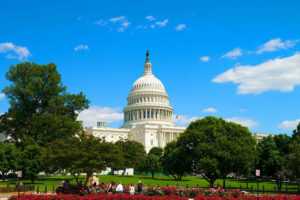
Before the Civil War, Capitol Hill was a beacon for free Black residents. Notably, in 1838, the Little Ebenezer Church was constructed as a powerful symbol of a community united in their pursuit of equality and unity, embodying their progressive spirit and promising future. This church still stands at the same location today and is now known as the Ebenezer United Methodist Church. It is one of the oldest continuously existing Black houses of worship in Washington.
Things To Do in Capitol Hill
Capitol Hill is more than just an iconic neighborhood; it is a living testament to America’s history and a symbol of its political power. The Capitol, with its towering dome and elegant neoclassical façade, is the seat of the United States Congress and an emblem of the American legislative process. Highlights of a visit here include a tour of the historic National Statuary Hall and the chance to witness Congress in session from the gallery.
Adjacent to the Capitol lies the Library of Congress, the largest library in the world, boasting an impressive collection of over 170 million items. The library’s primary building, the Thomas Jefferson Building, is a marvel of Beaux-Arts architecture, adorned with intricate mosaics and frescoes. A must-see is the library’s Main Reading Room, a grand two-story space with a magnificent stained-glass dome.
For a unique experience, embark on the Monuments by Moonlight night tour. This guided tour, conducted under the starlit sky, offers a different perspective of the city’s famous landmarks, including the U.S. Capitol, the Washington Monument, and the Lincoln Memorial. The tour’s twilight setting adds a layer of mystique to these monuments, and the guides’ narratives bring the city’s history to life in a memorable way.
Finally, a visit to Capitol Hill would be incomplete without stopping by the U.S. Supreme Court, the highest court in the land. This imposing marble edifice, with its grand Corinthian columns, houses the courtrooms where landmark decisions are made. Although court sessions are not open to the public, visitors can explore the grandiose public areas and perhaps take part in a lecture in the courtroom.
Brookland History
Brookland is often referred to as “Little Rome” or the “Little Vatican” due to the numerous religious institutions that call it home. The history of Brookland dates back to the early 1800s, when this region, situated to the north of Florida Avenue and to the east of the Potomac, fell within the jurisdiction of Washington County. The area was first subdivided in 1887, setting the stage for Brookland’s urban development.
The Catholic University of America, established in Brookland in the same year, became a cornerstone of the community, attracting several Catholic religious organizations. With its Gothic architecture and sprawling campus, it is an integral part of Brookland’s cultural and spiritual landscape.
Things To Do in Brookland
Towering over the neighborhood stands the Basilica of the National Shrine of the Immaculate Conception, the largest Catholic church in the United States. Explore its grandeur, or seek serenity at the Franciscan Monastery of the Holy Land, known for its beautiful gardens and replicas of holy sites. History buffs can delve into the past at the Catholic University of America, admiring its neo-Gothic architecture and art museum collection.
Embrace local art and flavors at the Monroe Street Arts Walk and explore vibrant galleries and studios showcasing local artists’ works. This unique outdoor complex includes 27 artist studios, galleries, and a variety of food and drink options. Savor diverse culinary experiences — from handcrafted brews and pub fare at Right Proper Brewing Company to authentic Neapolitan pizzas at Menomale.
Explore on foot or bike on the scenic Metropolitan Branch Trail, a six-mile paved path traversing the neighborhood, perfect for walking, biking, or simply enjoying the outdoors.
Columbia Heights History
Columbia Heights, a vibrant neighborhood in Washington, D.C., boasts a rich tapestry of history, culture, and transformation. Originally established in the early 1800s, the area was named after Columbian College (the institution that would become George Washington University), which relocated to the neighborhood in 1821. The late 19th and early 20th centuries saw Columbia Heights develop into a fashionable residential district, adorned with grand row houses that attracted affluent residents. The construction of the 14th Street streetcar line further enhanced its desirability and accessibility.
However, the mid-20th century brought challenges. The 1968 riots, sparked by the assassination of Dr. Martin Luther King Jr., left much of 14th Street—the neighborhood’s commercial spine—in ruins. The ensuing decades were marked by economic decline and social challenges. Yet, Columbia Heights began to witness a profound transformation in the late 1990s and early 2000s, rejuvenated by significant urban renewal efforts. The introduction of the Columbia Heights Metro Station in 1999 acted as a catalyst for change, ushering in a new era of development. Today, Columbia Heights stands as a testament to resilience and renewal. It is a diverse, bustling neighborhood, characterized by its historic architecture, lively cultural scene, and community spirit.
Things To Do in Columbia Heights
Columbia Heights thrives with a rich blend of cultures, intertwining histories, and captivating cityscapes. One of the must-see locations here is Meridian Hill Park, a beautifully landscaped urban park that sits on 12 acres of land. Designed in a distinct European neoclassical style, the park features cascading waterfalls, lined pathways, and a host of striking statues, including those of Joan of Arc and President James Buchanan, as well as a monument to Dante Alighieri.
Next is the Columbia Heights Dog Park, a haven for pet lovers and their four-legged companions. This fully enclosed, community-maintained park offers ample space for dogs to play and socialize. It’s a great place to experience the neighborhood’s welcoming and friendly vibe.
The lively core of Columbia Heights is 11th Street, the neighborhood’s main commercial thoroughfare. It’s filled with a variety of dining and shopping options that reflect the area’s rich cultural diversity. Stroll along this bustling street to explore local businesses, enjoy international cuisine, or sip on craft beers at local bars. Columbia Heights is a melting pot of history, culture, and urban energy, making it an unmissable part of a Washington, DC visit.
Foggy Bottom History
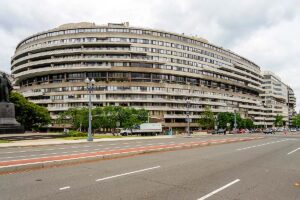
In 1949, the U.S. Department of State moved its headquarters to Foggy Bottom, adding a layer of political significance to the neighborhood. The last Washington Gas and Light factory, a symbol of the old industrial era, closed its doors here in 1954. Today, Foggy Bottom shines as an international hub of students, scholars, and professionals thanks to its vibrant mix of educational institutions, government buildings, and diverse populace.
Things to Do in Foggy Bottom
One of the key highlights of Foggy Bottom is the Kennedy Center for the Performing Arts. This premier cultural institution is the national stage for the performing arts in the United States. With its grand marble façade and sweeping views of the Potomac River, the Kennedy Center is a must-visit site.
Another treasure in Foggy Bottom is Rock Creek Park, an urban oasis offering trails for hiking, biking, and horseback riding, along with a planetarium and nature center. As the third-oldest national park in the country, it provides a refreshing break from city life. Its leafy trails and tranquil vistas offer a much-needed respite from the urban hustle and bustle.
Foggy Bottom is also home to the legendary Watergate Hotel. This iconic structure is known for its role in the 1972 political scandal that led to the resignation of President Richard Nixon. Today, it stands as a luxury hotel offering spectacular views over the Potomac River. With its storied past and strikingly futuristic design, the Watergate Hotel deserves a spot on every visitor’s itinerary.
The U.S. Department of State, with its numerous monuments and memorials, is another must-visit attraction. A tour of this iconic institution offers an insightful look into U.S. diplomacy and international relations. As a visitor, you can walk through the campus of George Washington University, soak in its academic atmosphere, and admire the historic buildings showcasing a variety of architectural styles.
Georgetown History
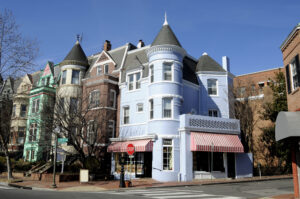
In the 1820s, the Potomac River experienced severe silting, which made it impossible for navigation up to Georgetown. This led to the initiation of the Chesapeake and Ohio Canal in July 1828, linking Georgetown to Harper’s Ferry, Virginia, an area that is now part of West Virginia.
Things To Do in Georgetown
With its cobblestone streets, Federal-style architecture, and elegant Georgetown row houses, Georgetown is not just a neighborhood; it’s a journey into the past. One of the most iconic landmarks in this area is the Old Stone House, the oldest unchanged building in Washington. Built in 1765, this beautifully preserved pre-Revolutionary structure offers a glimpse into 18th-century life.
Another must-see in Georgetown is Dumbarton Oaks. This historic estate, now a Harvard University research institute, possesses an extensive garden landscape that is a masterwork of famed designer Beatrix Farrand. Dumbarton Oaks also houses an impressive collection of Byzantine and pre-Columbian art, alongside a significant collection of European masterpieces.
The Chesapeake and Ohio Canal is a testament to Georgetown’s economic history. This now inactive waterway was once a critical artery for transporting coal, lumber, and other goods. Today, its picturesque towpath delivers an idyllic setting for walks, runs, or bike rides while taking in the neighborhood’s historic ambiance.
Logan Circle History
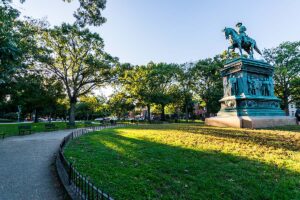
Beyond the confines of the Logan Circle Historic District, the neighborhood extends into the much larger Fourteenth Street Historic District, which was added to the National Register of Historic Places in 1994, further cementing the area’s historical status.
Things To Do in Logan Circle
Logan Circle, a renowned neighborhood in Washington, DC, exudes a unique blend of historic allure and modern sophistication. At its core is the Logan Circle Park — a traffic circle, park, and historic district. This park is home to a magnificent statue of Major General John A. Logan, a Civil War-era soldier, congressman, and senator whose dedication to veterans’ rights led to the creation of Memorial Day as a national holiday.
Near the park is the Studio Theatre, one of the city’s most respected cultural institutions. Known for its contemporary plays and thought-provoking performances, this theater fosters a deep appreciation for the arts within the community. Its intimate four-stage complex hosts an array of productions, promising an engaging experience to every theater enthusiast.
Further enriching Logan Circle’s cultural scene is Gallery Plan B, a prominent art gallery specializing in local and regional contemporary art. Displaying an eclectic mix of paintings, drawings, prints, sculptures, and mixed media, the gallery is a treasure trove for art aficionados. The regular exhibitions and events at Gallery Plan B provide an avenue for artists and art lovers to connect, making it a vital hub in Washington, DC’s art scene.
As you explore all of Washington, DC’s dynamic neighborhoods, remember that the Old Town Trolley is your ultimate ally in discovering some of the city’s best landmarks and hidden treasures. Offering a convenient hop-on, hop-off feature, the trolley allows you to leisurely traverse various areas at your own pace. Its narrated tours not only enhance the experience with fascinating insights into the city’s rich history and culture but also add an extra layer of fun to your journey. Let the Old Town Trolley be your guide, ensuring an unforgettable adventure through the heart of the Nation’s Capital.
FAQs
What DC neighborhood is known for its vibrant nightlife?
Dupont Circle, situated in DC’s core, is renowned for its lively nightlife, diverse eateries, and cultural gems, such as the Phillips Collection. This neighborhood also hosts numerous embassies and the National Geographic Society.
How many neighborhoods are there in DC?
Washington, DC comprises a rich tapestry of diverse neighborhoods, each with its unique charm and character. Officially, the city is divided into eight wards and 37 neighborhoods. However, if you include lesser-known, unofficial, or sub-neighborhoods, the number rises to over 100.
Which neighborhoods in DC are known for their historical significance?
Several neighborhoods in Washington, DC are known for their historical significance and immersive experiences for tourists. Capitol Hill, Georgetown, Dupont Circle, and Logan Circle stand out as historically rich areas, featuring iconic landmarks, historic homes, and vibrant cultural scenes. These neighborhoods offer visitors a chance to delve into the city’s past and experience its diverse heritage through guided tours, historic architecture, and immersive art and tech experiences.




